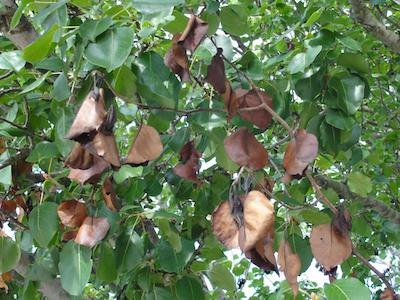
Fireblight is a common bacterial disease on ornamental and edible pears.
July 23, 2023 - Summer Gardening Questions
Q: There are many small dead branches in my Bradford pear. What is causing it and what can I do about it?
A: That’s fireblight, a common bacterial disease that affects members of the rose family. It’s spread by splashing water and wet springs exacerbate it. Unfortunately, there’s no cure for it other than planting blight resistant cultivars. Most ornamental cultivars of Pyrus calleryana have moderate to good resistance along with most hard canning pears. Soft European pears like ‘Bartlett’ are highly susceptible and will generally die from severe fireblight infection. Pruning, fertilizing, and overhead watering all encourage fireblight and should be avoided.
Q: It’s so hot. I water my lawn three times a week. Is that enough?
A: It’s more than enough. In fact, it’s too often. Lawns should be watered manually only once a week (when it doesn’t rain), one to one and a half inches at a time. This can be measured using tuna cans, baby food jars, or any other containers to find out how long it takes to catch an inch or more. Watering frequently in limited amounts leads to shallow roots and increased disease susceptibility. Deep watering creates deep roots and leads to increased drought tolerance.
Q: The needles on my pines are turning brown and falling off. What gives?
A: It’s perfectly normal for pine trees to drop their inner needles during late summer. It’s a natural occurrence to be expected annually.
Q: Are there any flowers that can tolerate this searing heat? My petunias, geraniums, and zinnias are all dying.
A: Duranta, esperanza, firebush, lantana, Mexican heather, ornamental sweet potatoes, pentas, periwinkles, plumbago, purslane, thryallis, and tropical milkweed can all tolerate 100-degree temperatures.
Q: Why are all the oak trees dying? Is it a disease?
A: The far majority of the dead and dying oaks in East Texas are the result of the 2021 devastating freeze. Many that suffered partial freeze damage died in the 2022 drought. This injury was primarily on live oaks, post oaks, Southern red oaks, and water oaks. Live oak damage was the result of genetics and provenance since they are a coastal tree. The others were the result of not being hardened off (preconditioned) for such cold temperatures. Plants do not like drastic changes in temperatures. Unfortunately, there is nothing to do about it other than having them removed and replacing them with new trees in the fall.
Q: Is it true that watering during the heat of day will scorch and kill plants?
A: No. This is a common wives’/husbands’ tale. If a plant is dry and wilted it should be watered, no matter what time of day or what temperature it is. Just make sure and run water through the hose first so it doesn’t come out boiling! It doesn’t hurt plants to be slightly wilted before being irrigated. Just make sure to water them thoroughly by saturating the entire root zone.
Greg Grant is the Smith County horticulturist for the Texas A&M AgriLife Extension Service. He is the author of Texas Fruit and Vegetable Gardening, Heirloom Gardening in the South, and The Rose Rustlers. You can read his “Greg’s Ramblings” blog at arborgate.com and read his “In Greg’s Garden” in each issue of Texas Gardener magazine (texasgardener.com). More science-based lawn and gardening information from the Texas A&M AgriLife Extension Service can be found at aggieturf.tamu.edu and aggie-horticulture.tamu.edu.








